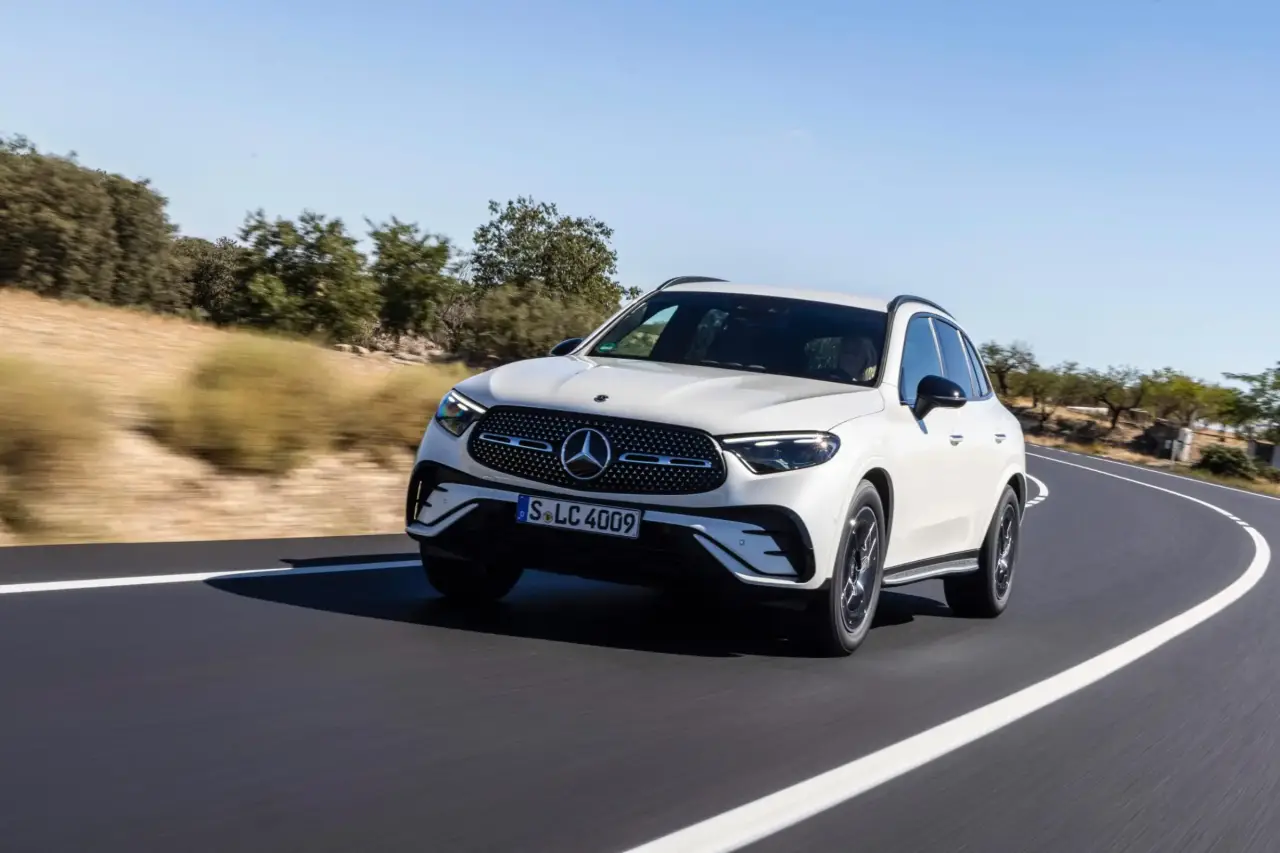The new 2022 Mercedes-Benz GLC - Dynamic, powerful and exclusively with electrified drive
The new Mercedes-Benz GLC is even more dynamic, powerful and sustainable. It is available only as a hybrid: either as a plug-in hybrid or as a mild hybrid with 48-volt technology and integrated starter generator. The plug-in hybrids offer a range of more than 100 kilometres (WLTP). The GLC thus sets new standards in the all-wheel drive SUV segment. Systematic electrification of the GLC, the company's best-selling model series, makes a significant contribution to reducing the CO2 balance over the entire lifecycle. The new GLC is on the way to climate-neutral mobility, which is the goal of "Ambition 2039". The technical highlights of the GLC also include special equipment such as DIGITAL LIGHT, rear-axle steering and new assistance systems. Its pronounced off-road suitability is underlined by features such as electric off-road driving in the plug-in hybrids, or the "transparent bonnet". The GLC will be in the showrooms of our western European sales partners from autumn 2022.
The new GLC is immediately recognisable as a member of the Mercedes-Benz SUV family. Standard equipment includes the AVANTGARDE Exterior line with Chrome package and 18-inch light-alloy wheels. This adds striking design features and enhances the unique proportions of the vehicle.
Exterior design: Expressive highlights
One of the defining design highlights of the GLC is the redesigned front end, with headlamps that connect directly to the radiator grille to emphasise the vehicle's width. DIGITAL LIGHT headlamps with additional daytime driving light ellipses and new blue trim, plus active ground lighting, also in blue, are available as optional extras. The typical Mercedes SUV radiator grille with redesigned cut-out has a chrome surround. This frames a sporty louvre in matt grey with chrome trim and the grille with vertical louvres in high-gloss black. From AMG Line upwards, a radiator grille with Mercedes-Benz pattern is available: a three-dimensional star pattern with high-gloss chrome surfaces. The new simulated underguard in chrome at the front emphasises the vehicle's width and accentuates the off-road look.
The body design is characterised by a full, spanned surface design enriched with precisely shaped edges in the sides. These emphasise the proportions as well as the muscular wheel arches, and also create a balance between elegance and off-road performance. Wheel arch liners in the vehicle colour are available from AMG Line upwards for the first time. These accentuate the sportiness of AMG Line. Also available as an optional extra are easy-entry running boards and the Night package.
Other features of the sporty, confident appearance are the wide track and flush wheels in 18 to 20-inch size. Several of the wheels available ex factory not only feature a modern design with a high-sheen finish and bicolour surfaces, but are also aerodynamically optimised.
The new two-section rear lights with a handle strip in high-gloss black emphasise the width of the rear. Their interior has a three-dimensional look, and as an optional extra they are available with an animation. The rear end also has a simulated chrome underguard, which encases the simulated chrome-look tailpipes.
Interior design: modern, sporty luxury
Welcome to the modern, sporty luxury of Mercedes-Benz: this is the message the interior of the new GLC with AVANTGARDE line already sends out in its standard configuration. It continues the familiar, successful concept, adopting highlights and developing them further with its own keynotes.
The dashboard is clearly structured: the upper section has a wing-like profile with new, flattened round nozzles reminiscent of the engine nacelles of an aircraft. The lower section has a generous trim area that flows harmoniously into the curved centre console. Its orientation towards the driver contributes to sportiness: the dashboard is slightly angled towards the driver by six degrees.
There is a free-standing, high-resolution LCD screen in front of the driver. It appears to float in front of the wing profile and trim area. This sets the driver's display apart from traditional cockpits with classic dial instruments. It has a size of 12.3 inches (31.2 centimetres).
A high-quality chrome insert divides the centre console into a rear, softly padded area for the armrest and a front area in glossy deep black. The central display rises seamlessly and seemingly without joints from this three-dimensional surface. It appears to float above the trim area.
The central display also makes the paradigm shift towards digitisation clear: the vehicle functions can be controlled using the high-quality touchscreen. Its portrait orientation is particularly advantageous for navigation. Like the dashboard, the screen surface is slightly angled towards the driver. The central display has a screen diagonal of 11.9 inches (30.2 centimetres). Ergonomically located below the central display is a fingerprint scanner. A colour head-up display can be ordered as optional equipment.
The modern, highly reduced design of door panels frames both ends of the dashboard. The door centre panel with integrated armrest evolves from a vertical surface into a horizontal orientation. Reflecting the design of the centre console, the front section takes the form of a metallic high-tech element. It can be used as a grab or closing handle, and houses the power window controls. Another highlight is the floating control cluster, into which the door opener and seat adjustment controls are integrated.
The avant-garde seat design of the new GLC plays with layers and contoured surfaces, lending them visual lightness. The head restraints and their connection to the backrest with an enclosed cover have been redesigned. The new GLC is available with a leather-lined dashboard with nappa-look beltlines (optional, standard for AMG Line). Some trim elements have innovative surfaces. These include new interpretations of open-pored veneers in brown tones, as well as an open-pored, black wood veneer featuring fine, form-following inlays in real aluminium. On request, direct ambience lighting with light guides replaces the standard indirect ambience lighting.
Intuitively operated and learn-capable: Latest generation of MBUX
After the S-Class and C-Class, the new GLC also has the second generation of the MBUX (Mercedes-Benz User Experience) infotainment system. The vehicle interior becomes even more digital and intelligent, as both the hardware and software have made great strides: On the LCD screens, brilliant images make it easy to control vehicle and comfort functions.
The driver and central display offer a holistic, aesthetic experience. The information is presented in a clearly structured way. The appearance can be individualised with a total of three display styles (classic, sporty, discreet) and three modes (navigation, assistance, service). In addition, the GLC offers the off-road mode.
- In "Classic" style, the driver is welcomed with a familiar display environment. The proven display of two tubes and alternating content in between provides all driving-related information.
- In "sporty", the colour red dominates and the central rev counter is dynamically presented.
- In "discreet" style, the content is reduced to what is essential. In addition, both screens can be shown in seven colour schemes with the ambience lighting. This creates an impressive colour experience in the interior.
- The "assistance mode" displays the traffic situation in real time and supplements it with important display information.
- The new "off-road mode" makes specific content such as gradient, inclination, compass and steering angle visually tangible and, in conjunction with the optional 360-degree camera, offers the "transparent bonnet" function.
The full-screen navigation offers the driver the best possible guidance while driving. Augmented Video is available as optional equipment. A camera registers the surroundings in front of the vehicle. The central display shows the moving images and also superimposes virtual objects, information and markers. These include, e.g. traffic signs, directional arrows, lane-change recommendations and house numbers. This can make navigation much easier, especially in urban areas.
Hey Mercedes: the increasingly sharp voice assistant
The voice assistant "Hey Mercedes" becomes more interactive and capable of learning by activating online services in the Mercedes me App. Moreover, certain actions can be performed even without the activation keyword "Hey Mercedes". These include taking a telephone call, for example. "Hey Mercedes" also explains vehicle functions with the voice command "Help", and provides assistance e.g. when wanting to connect a smartphone via Bluetooth or looking for the first-aid kit. Hey Mercedes even recognises vehicle occupants by their voices.
Tourguide: audio travel guide in MBUX
As part of the "MBUX Voice Assistant" from Mercedes me, the audio "Tourguide" adds an interesting and entertaining feature to the previous travel information functions. In response to the voice command "Hey Mercedes, start Tourguide", the MBUX infotainment system reads out extensive information about points of interest along the route. The system responds to the approximately 3400 brown signs along German motorways. The new audio Travelguide is initially available exclusively in Germany, but will later be rolled out in other countries.
Smart Home: Mobile intelligence for maximum operating convenience from a distance
With the MBUX Smart Home function, the GLC now becomes a mobile control centre for the home. Because Smart Home refers to WLAN, sensors and actuators making the home increasingly intelligent and communicative: temperature and lights, shutters and electrical appliances can be remotely monitored and controlled. Motion detectors and window contacts inform the user of welcome or unwelcome visitors.
"Hey Mercedes, is there anybody in my home right now?" "I checked. The last movement detected was in the kitchen one hour ago." In future, for example, dialogues can be conducted via the MBUX (Mercedes-Benz User Experience) voice assistant between the driver or passenger in the GLC and the user's smart home. At the market launch, the MBUX Smart Home function will support numerous devices offered by important smart home providers – corresponding contracts have already been concluded with Bosch Smart Home and Samsung SmartThings. Further providers will follow, and be announced at a later stage. Right from the start, Hey Mercedes understands questions and commands in four languages (German, Chinese, US and British English). Lamps, sockets, thermostats, shutters and blinds, motion detectors, door and window contacts and temperature sensors can be addressed. So the system can also answer this question: "Did I remember to turn the heating down?" Depending on the response and the thermostats installed in the home, it is possible to change the setting: "Set the temperature to 18 degrees in the whole house!" It also enhances comfort, because the heating can also be remotely turned up again in good time.
Music: Streaming and sound systems
With the "Online Music" service, Mercedes-Benz has fully integrated the largest music streaming providers into the MBUX infotainment system. MBUX allows seamless access to the personal user profile at the linked music provider. In this way, customers not only have convenient access to their favourite songs and their own playlists, but also the opportunity to discover millions of songs and curated playlists. Operation is intuitive using the MBUX voice assistant, touch controls on the steering wheel or directly on the central display. In addition to the standard sound system with a front bass woofer and four mid-range speakers, optional extras are available:
- Advanced Sound System. This comprises nine speakers - five midrange, two tweeters, two front bass speakers with 2 x 50 watts from an auxiliary amplifier and a total output power of 225 watts.
- Burmester® surround sound system, specially configured for the GLC by this sound specialist. It comes with a total of 15 premium speakers: seven 50-watt midrange speakers, four 20-watt tweeters, two 20-watt 3D speakers and two premium front bass speakers at 120 watts each. A 15-channel amplifier drives all speakers fully actively with a total output of 710 watts. In addition, high-quality sound presets, optimisation via a digital signal processor, individual sound settings and staged operation bring the system to life. The metal speaker grilles bear the Burmester® lettering.
Further highlights: Head-up display and fingerprint sensor
A colour head-up display can be ordered as optional equipment. The driver is presented with a virtual image measuring 9 x 3 inches (around 23 x 8 centimetres) floating a good 3 metres ahead of the bonnet. This is roughly equivalent to a 25-inch monitor. The head-up display consists of a full-colour display module with a native resolution of 800 x 480 pixels, illuminated by high-power LEDs. A mirror optics unit projects the virtual image onto the windscreen and into the driver's field of vision. Sensor-controlled, the display brightness automatically adjusts to the outside conditions.
With the fingerprint scanner, users can log in to MBUX quickly, conveniently and securely. Because personal settings and data such as favourites, last destinations, behaviour-based predictions, professional calendar entries or emails are protected. Payment processes via Mercedes me are also restricted to authenticated users.
"Over-the-air" (OTA) updates: The very latest software
As soon as a new software update is available from Mercedes-Benz, a message appears in MBUX. Download and installation take place in the background. The user must then explicitly agree to activation of the update. This means that the vehicle always remains up to date. New features can also be uploaded to already sold vehicles by over-the-air updates. For data transmission, Mercedes-Benz relies on the high security standard provided by mobile radio technology and the communication module installed in the vehicle.
Another way to an updated and improved user experience is to add new features in the Mercedes me Store, such as music streaming or in-car office functions. Subscription services can also be renewed or rebooked directly online via the Mercedes me Store.
Powertrain: More electric than ever
The new GLC is available only as a hybrid: either as a plug-in hybrid or as a mild hybrid with 48-volt technology and integrated starter generator. The engine range has four-cylinder units from the current FAME (Family of Modular Engines) Mercedes-Benz engine family. Accordingly, the engine range plays a major role in the flexibility of the international production network, with needs-based electrification. The power spectrum of the four-cylinder engines ranges up to 190 kW and 400 Nm of torque in the petrol models, and up to 195 kW and 550 Nm in the diesel models, each plus up to 17 kW and 200 Nm of electrical support from the ISG.
Systematic electrification means:
- All the drive systems available for the GLC are hybrids.
- Four of these are mild-hybrid units, which receive intelligent support in the low rpm range with a second-generation integrated starter-generator (ISG) in conjunction with a 48-volt electrical system.
- Three further engine variants are plug-in hybrids, including an all-electric driving mode and a range of more than 100 kilometres.
The integrated starter-generator with the petrol and diesel engines provides intelligent support in the low rpm range. In combination with turbocharging, this ensures excellent power delivery. The system includes the 48-volt electrical system, which enables functions such as "gliding", boost or recuperation and thus significant fuel savings. In addition, the engines start very quickly and comfortably with the help of the ISG, so that the start-stop function is almost imperceptible to the driver, as is the transition from "gliding" with the engine stationary to powerful propulsion with engine power. When idling, the intelligent interaction between the ISG and the combustion engine ensures outstandingly smooth running.
Transmission: Automatic is standard equipment
The 9G-TRONIC automatic transmission is standard equipment in all GLC models. This has been developed further for ISG adaptation: the electric motor and the power electronics are accommodated in the transmission housing, and thermal management of both components is carried out via the transmission cooling system. Previously necessary lines are therefore no longer required, which offers advantages in terms of installation space and weight. In addition, the gearbox has a higher efficiency. Among other things, optimised interaction with the electric auxiliary oil pump reduces the delivery volume of the mechanical pump by 30 percent compared to its predecessor - good for efficiency. Furthermore, it uses a new generation of the fully integrated transmission control with multi-core processor and new design and connectivity technology. In addition to the increased computing power, the number of electrical interfaces has been drastically reduced.
All-wheel drive: Mercedes-Benz 4MATIC
All models of the new GLC come with the latest 4MATIC all-wheel drive system. The new front-axle drive allows higher torque levels to be transferred, with an ideal axle load distribution for driving dynamics. This also has a considerable weight advantage compared to the axle drive of the preceding series. The longitudinal transfer case, which is also new, further reduces friction losses. It also has a closed oil circuit and does not require any additional cooling measures.
Diesel with integrated second-generation starter-generator
The OM 654 M with integrated second-generation starter-generator and 48-volt onboard power supply is at the forefront of efficient drive technology. Recuperation and the possibility to "glide" with the engine switched off further increase efficiency. Apart from electrification including an electric refrigerant compressor for the air conditioning system, these are the most important changes for the output of up to 198 kW plus a boost of 17 kW by the ISG:
- Stroke of 94.3 millimetres and displacement of 1993 cc (previously: 92.3 and 1950) thanks to new crankshaft.
- 2700 bar injection pressure (previously 2500).
- Particularly fast response and smooth power delivery thanks to two water-cooled turbochargers, now both with variable turbine geometry.
- Cooling channel in the steel piston filled with sodium for effective reduction of temperature peaks in the piston crown.
These are the exhaust aftertreatment components for the diesel:
- A close-coupled NOx storage catalytic converter to reduce nitrogen oxides.
- A diesel particulate filter (DPF) with special coating, also to reduce the nitrogen oxides.
- A near-engine mounted SCR (Selective Catalytic Reduction) catalytic converter with metered injection of AdBlue®).
- an additional SCR catalytic converter in the vehicle's underbody, with a separately metered injected quantity of AdBlue®
Four-cylinder petrol engine with second-generation ISG.
After the C-Class, the new GLC is the second Mercedes-Benz model series to receive the four-cylinder M 254 petrol engine with integrated second-generation starter-generator (ISG). The ISG provides up to 17 kW of additional power and 200 Nm more torque, can recuperate higher electrical outputs than a belt-driven starter generator, shifts the load point of the combustion engine and allows hybrid functions such as "gliding" with the engine switched off, boosting and recuperation. This makes the petrol engines very efficient. In the M 254, Mercedes-Benz has also combined all the innovations of the modular engine family of four and six-cylinder petrol and diesel engines in a single unit. They include NANOSLIDE® cylinder coating, CONICSHAPE® cylinder honing (trumpet honing) and the exhaust aftertreatment system positioned directly at the engine. All the engines are characterised by superior power delivery, smooth running and excellent noise comfort.
The segmented dual-flow turbocharger has been completely redeveloped as a further development of the twin-scroll technology, for an even more spontaneous response. This turbocharger is the result of collaboration between Mercedes-Benz turbocharger development and the Mercedes-AMG Petronas Formula 1 team. The technology transfer to series production sets new standards in terms of performance combined with maximum efficiency.
Plug-in hybrids: more than 100 kilometres electric range (WLTP)
The GLC also receives the fourth-generation plug-in hybrid drive in three power levels. Using the identical basic engines, electrification has taken another big step. With an electric drive power of up to 280 kW (381 hp) and an all-electric range of more than 100 kilometres (WLTP), the plug-in hybrid models of the GLC will in many cases and on many days be on the road purely electrically, without the use of the combustion engine. Whether with one of the two petrol engines or the diesel: as plug-ins, they are not only very efficient but also extremely dynamic on the road.
The new high-voltage system is more compact and more powerful. The number of high-voltage interfaces is significantly reduced. Integration of the power electronics into the transmission housing reduces the required installation space and simplifies assembly processes in production. In addition, a higher system voltage increases the drive power without the need for larger cable cross-sections.
The high power density of the hybrid drive unit comes courtesy of a permanently excited internal rotor synchronous motor. The 440 Nm peak torque of the electric motor is ready to go right from the start, resulting in high agility when moving off, along with dynamic driving performance. The full electric power is available up to 140 km/h.
The high-voltage battery is an in-house development by Mercedes-Benz. In particular, the total capacity of 31.2 kWh in combination with more efficient recuperation and improved aerodynamics allow an all-electric range of more than 100 kilometres. To accommodate the high power density, the high-voltage battery has an internal cooling system. The thermal management system can therefore control the operating temperature irrespective of the climate control in the vehicle interior. In addition to continuous operation in hot and cold regions, this also allows quick charging with direct current.
Even when the battery is completely discharged, it can be fully charged in around 30 minutes with the optional 60 kW DC charger. A standard-fit 11 kW charger (depending on the market) is available for three-phase charging at a Wallbox connected to the domestic AC mains. The standard charging cable can be stored within easy reach in a floor compartment just behind the tailgate.
Charging at public charging points becomes a pleasant secondary matter with Mercedes me Charge. The charging network with around 300,000 charging points in Europe offers three charging tariffs that are tailored to the individual driving distances. This makes charging with Mercedes me Charge even easier and more transparent. Drivers of a plug-in hybrid from Mercedes Benz receive an exclusive price advantage for public charging, with fixed price rates per kilowatt hour of electricity in the first year after registration. In addition, the monthly standing charge of 4.90 euros in the M tariff is waived in the first year for new car buyers. This appeals to city commuters, for example.
Mercedes me Charge gives customers access to a wide range of public charging stations located in cities and in places like shopping centres, hotels or service stations. The Mercedes me App indicates the exact position, current availability and price at the selected charging station in advance. Further information on Mercedes me Charge: https://media.mercedes-benz.com/article/6872cfc4-7bbd-421e-871d-c7c774c6c5d5.
Recuperate instead of braking
Also thanks to improved recuperation, the new GLC offers significantly higher overall efficiency of the hybrid system compared to its predecessor: The amount of recovered electrical energy has increased significantly.
Recuperation recovers electricity for the e-drive from the vehicle's kinetic energy. It is based on an interlocking interaction between the components: while the electric motor receives electrical energy during acceleration to generate mechanical energy, it is mechanically driven by the vehicle's kinetic energy on the overrun and during deceleration, thus working as a generator and generating electrical energy. This is fed into the vehicle's high-voltage battery and is available for the drive system.
A decisive factor for efficiency in recuperation is the interaction of the hydraulic service brake with the electric motor. In addition, the automatic transmission performs several gearchanges during deceleration. The use of a vacuum-independent braking system in the new GLC has significantly optimised the entire interaction. Depending on the driving situation and the driver's braking requirements, this braking system automatically controls the flexible transition between hydraulic braking and recuperation. This allows the maximum recuperation power of up to 100 kW to be achieved more frequently, and over a longer period of time. For this purpose, the system variably reduces the braking power of the hydraulic brake, even at constant pedal pressure, so that the high recuperation power is maintained as speed decreases. A further, pleasant effect for the driver is that he/she does not perceive this automatic transition.
The graph below illustrates the advantages of the hybrid drive in the new GLC.
The curves in the diagram compare example braking of the new GLC and its predecessor from 100 km/h to standstill with constant deceleration. The diagram clearly shows that the initial braking power is significantly higher than the maximum recuperation power. The recuperation time with maximum recuperation power is significantly longer in the new GLC, as the new system can flexibly reduce the contribution made by hydraulic braking. This is where the new GLC scores: significantly higher recovery of electrical energy from kinetic energy than in the preceding model. This has a positive effect on the electric range.
The optimised driving modes of the new GLC plug-in hybrid support the management of recuperation and optimal use of the available electrical energy. Based on the information from the route guidance of the navigation system, the hybrid driving programme provides the electric driving mode for the most appropriate route sections in each case. Electric driving is prioritised on journeys in urban areas, for example.
A driver wishing to influence the energy recovery rate can do so directly in three stages controlled by rocker switches behind the steering wheel. This is possible in all driving modes except SPORT. In the driving mode D-, for example, the driver can experience the "one-pedal feeling": when the driver takes his/her foot off the accelerator, the vehicle slows down purely electrically to the extent that the hydraulic operating brake is often not needed. In addition the operating strategy communicates with the sensors of the assistance systems, efficiently supporting the driver in many situations.
Two driving modes allow the driver to use the possibilities of the plug-in drive in a particularly targeted manner:
BATTERY HOLD: Priority is given to preserving the charge state of the high-voltage battery, for example when planning to drive in a city centre or low emission zone later on. The hybrid drive system selects the appropriate drive depending on the driving situation and distance.
ELECTRIC: Electric driving up to 140 km/h, activation of the combustion engine via the pressure point of the accelerator pedal.
If the route-based operating strategy is activated, data on the expected route is evaluated when route guidance is active. This takes into account factors such as navigation data, topography, speed limits and the traffic conditions for the entire planned route. With the route-based operating strategy, the two forms of energy of the hybrid vehicle can be distributed in the best possible way. The drive control automatically selects the most suitable operating mode so that the state of charge of the high-voltage battery can be specifically influenced. For example, electrical energy can be saved for e-driving so as to drive all-electrically in inner-city areas or in environmental zones later on.
In the HYBRID and ELECTRIC driving modes, as well as in BATTERY HOLD, the ECO Assistant also evaluates the route data and supports the greatest possible efficiency and recuperation energy according to the route. If the navigation map or sensors and cameras detect e.g. a roundabout ahead, a hairpin bend, a tight bend, a T-junction, a gradient, a vehicle in front or a speed limit, the ECO Assistant calculates the optimum vehicle speed from the distance, speed and gradient. For any necessary deceleration, the hybrid system primarily uses the electrical resistance of the electric motor for recuperation.
The plug-in hybrid variants of the new GLC have a haptic accelerator pedal module. In the ELECTRIC driving mode, this signals the change from electric driving to driving with the combustion engine by means of a perceptible pressure point. If the pressure point is exceeded, the combustion engine is switched on and provides additional drive torque.
All in all, driving with the new GLC plug-in hybrid becomes significantly more electric. Thanks to the increase in electric range to more than 100 kilometres, everyday journeys can largely be covered purely electrically.












